Embraced by a long meander in the Aare River, Bern is surely one of Europe’s prettiest cities, and has an old centre listed as a UNESCO World Heritage Site.
The Medieval core was rebuilt in stone after a fire in the 15th century, lending it a cohesive appearance that has made it through to present times.
Bern’s famous sandstone frontages are supported by a network of arcades weaving along the Medieval city streets and adding up to six kilometres.
Bern is Switzerland’s administrative seat, endowed with the culture and monuments befitting the country’s de facto capital.
The natural setting also adds to Bern’s charm, with gorgeous views from the Gurten mountain and the steep right bank of the Aare, while the snowy peaks of the Bernese Highlands are always visible in the distance.
1. Old City
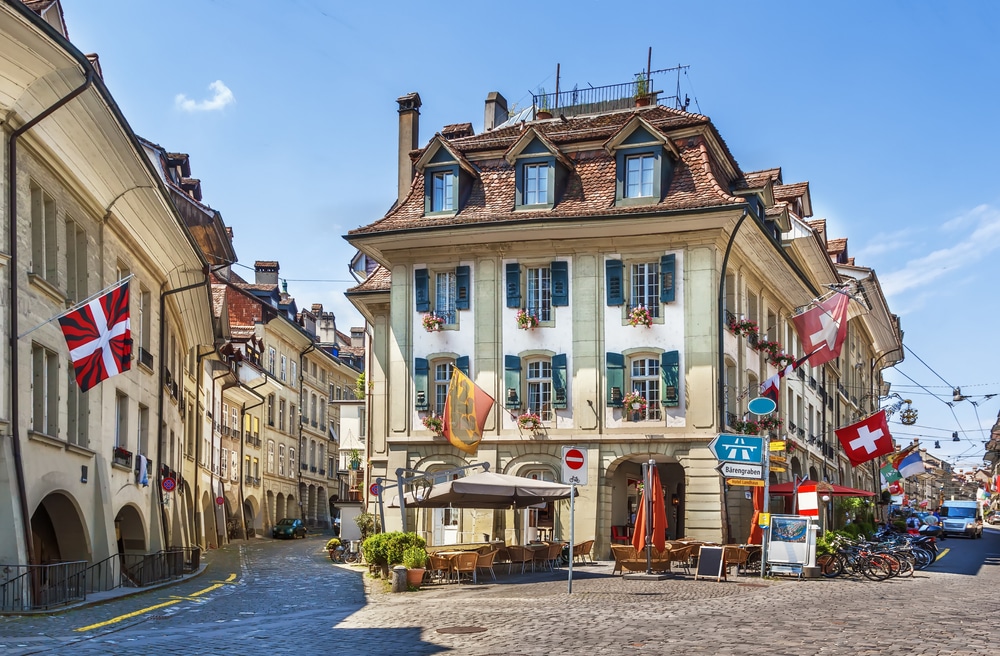 Source: Borisb17 / Shutterstock
Source: Borisb17 / ShutterstockIn 1405 Bern was wiped out by a fire that spread quickly through its tightly packed wooden buildings.
Because so much of the city needed to be rebuilt in such a short space of time, the Old City now has a rare degree of architectural unity.
That disaster has also helped to preserve Bern’s Medieval layout, literally setting the 12th-century street plan in stone.
So even as the facades changed with the times, and are mostly from the 18th century, a time-traveller from the 1190s would recognise the basic layout of everything east of the Zytglogge clock tower.
The defining feature is a set of three parallel, arcaded main arteries along the length of the peninsula, broken at precise intervals by side alleys, with the broad Kramgasse/Gerechtigkeitsgasse threading through the middle.
In the 1540s, as Bern became a powerful city-state, a series of beautiful drinking fountains crowned with allegorical statues cropped up on these streets. Eleven survive today, nearly all of which were carved by the Fribourg master, Hans Gieng (d.1562).
2. Six Kilometres of Arcades
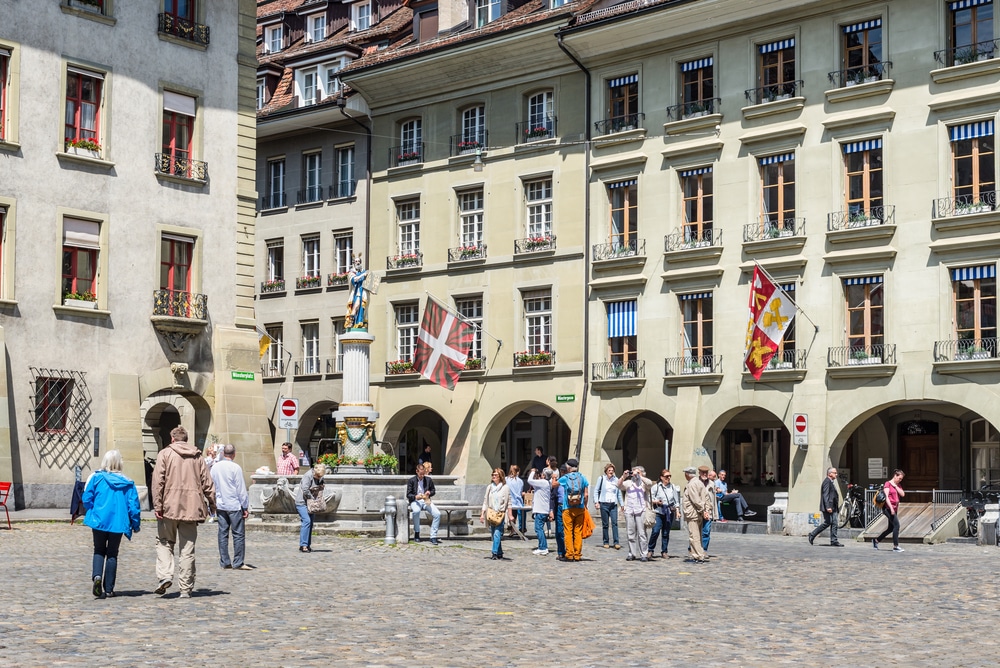 Source: byvalet / Shutterstock
Source: byvalet / ShutterstockYou can thank that devastating blaze in 1405 for making Bern one of the most exciting places in Europe to go on a shopping expedition.
The Old City was quickly reconstructed in sandstone, but as new levels were added above throughout the 15th century, arcades needed to be added below to support them.
And even as the buildings were modified over the next three centuries, the elegant, continuous arcades stayed in place, and are a constant feature of the UNESCO World Heritage Site.
Hiding in converted old cellars are fashion emporia, one-of-a-kind boutiques, galleries and a cosmopolitan array of cafes and restaurants.
Münsterplatz, the arcaded plaza in front of the cathedral is one of two locations for Bern’s weekly market, and a very picturesque place to do your grocery shopping on a Tuesday or Saturday.
3. Bern Minster
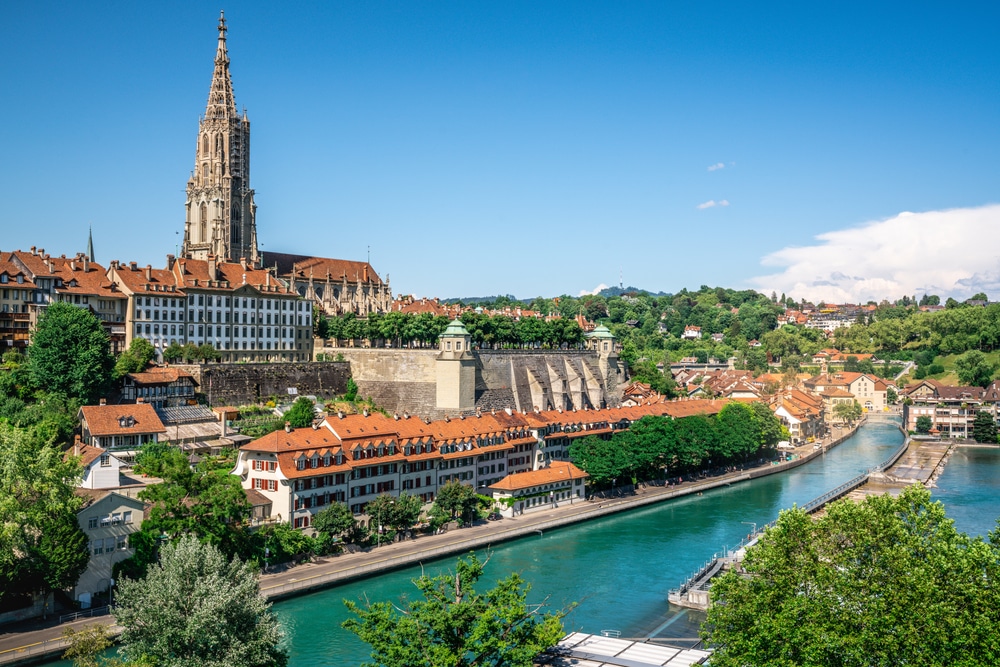 Source: Keitma / Shutterstock
Source: Keitma / ShutterstockBy far the most prominent landmark on Bern’s silhouette is the 100-metre tower of Bern Minster.
This cathedral, built from local sandstone, went up mostly in the 15th century to reflect Bern’s growing wealth and power as a major city-state.
Although the octagonal base of the tower was completed in 1518, the remainder of this structure, now housing the largest bell in Switzerland, wouldn’t be completed until 1893.
The climb to the view deck, up 312 steps is arduous, but will be rewarded with staggering views of the city and the snow-capped peaks of the Bernese Highlands.
Iconoclasm in the 16th century took out most of the cathedral’s once lavish decoration. But a sensational group of Late Gothic sculpture, one of the greatest in Europe, survives in the main portal.
Filling the jambs, tympanum and archivolts, the work represents the Last Judgement, showing the damned on the right and the saved on the left.
All of the 170 smaller figures in the group are original, carved between 1460 and 1480, while the 47 larger, free-standing sculptures are replicas, and the originals are kept at the Bern Historical Museum.
4. Zytglogge
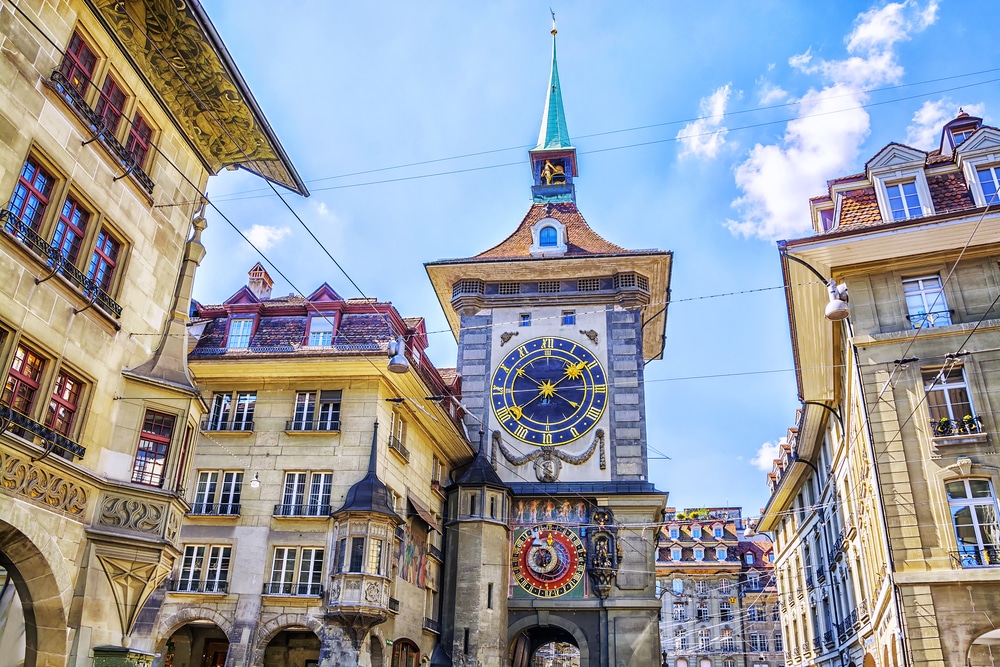 Source: MarinaD_37 / Shutterstock
Source: MarinaD_37 / ShutterstockWith its 15th-century astronomical clock and intricate bellworks, this tower is one of those sights that springs to mind when you think of Bern.
The tower started out in the late-12th century as Bern’s western gate, but within 100 years had become part of the second line of defences and then a prison for women who had sexual relations for clergy.
By the beginning of the 15th century the tower sported an astronomical clock, which was gradually refined and expanded until 1530 when its clockwork was entirely rebuilt by the mechanic Kaspar Brunner (d.1561).
As Bern’s main clock, the Zytglogge set the rhythm for life in the city and the wider canton, and the great hour bell (“Zytglogge” means time bell in Bernese German) is unchanged since the tower was reconstructed after the fire in 1405.
On the hour every hour, you can watch a little show given by a group of automated Medieval figurines, including dancing bears, a fool and rooster, as well as a gilded jacquemart striking the hour bell.
If you’re intrigued by the tower’s history and want to see the intricate clock mechanism in action you can book a guided tour.
Website: http://www.zeitglockenturm.ch/en/
5. Zentrum Paul Klee
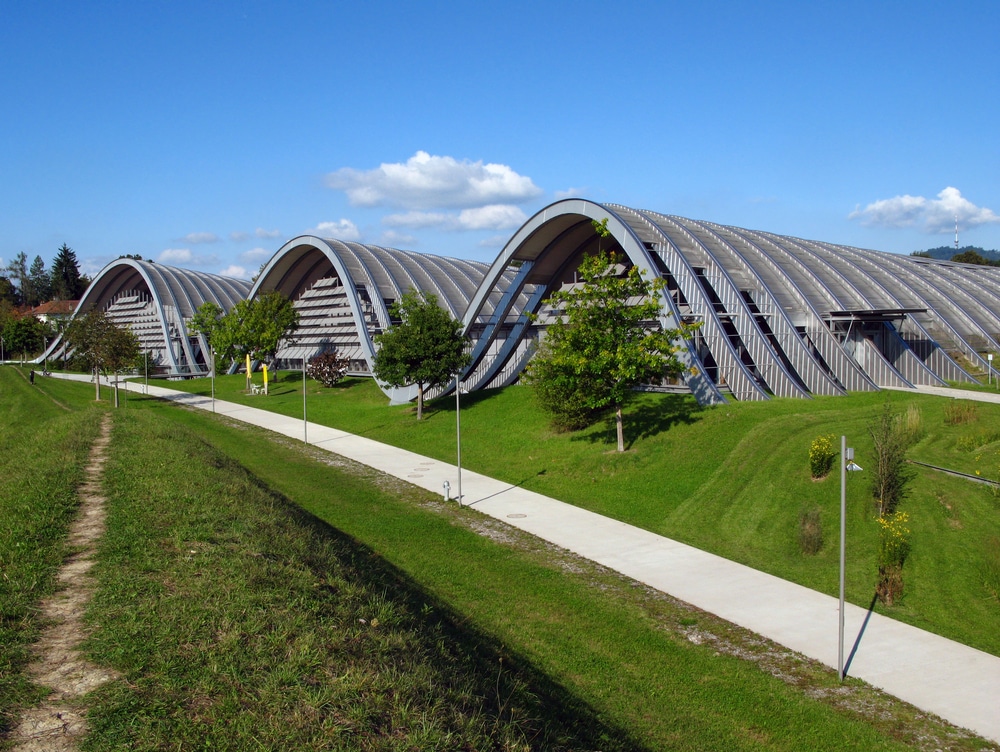 Source: Mihai-Bogdan Lazar / Shutterstock
Source: Mihai-Bogdan Lazar / ShutterstockThe world’s largest collection of works by Bern-born artist Paul Klee (1879-1940) belongs to this museum, opened in 2005 in a distinctive waveform building designed by Renzo Piano,
With 4,000 paintings, watercolours and drawings, the Zentrum Paul Klee possesses around 40% of the artist’s entire oeuvre.
Klee’s influence is impossible to exaggerate, as a constant innovator in the first half of the 20th century, and a member of Der Blaue Reiter, teacher at Bauhaus and one of history’s foremost colour theorists.
And such is the depth of the museum’s holdings that it gives rise to immersive thematic exhibitions shedding new light on the evolution of Klee’s output and his unique perspective.
A few masterpieces to keep an eye out for are Fischzauber (1925), Regentag (1931), Ad Parnassum (1932) and Paukenspieler (1940).
Website: https://www.zpk.org/en/startseite-245.html
6. Gurten
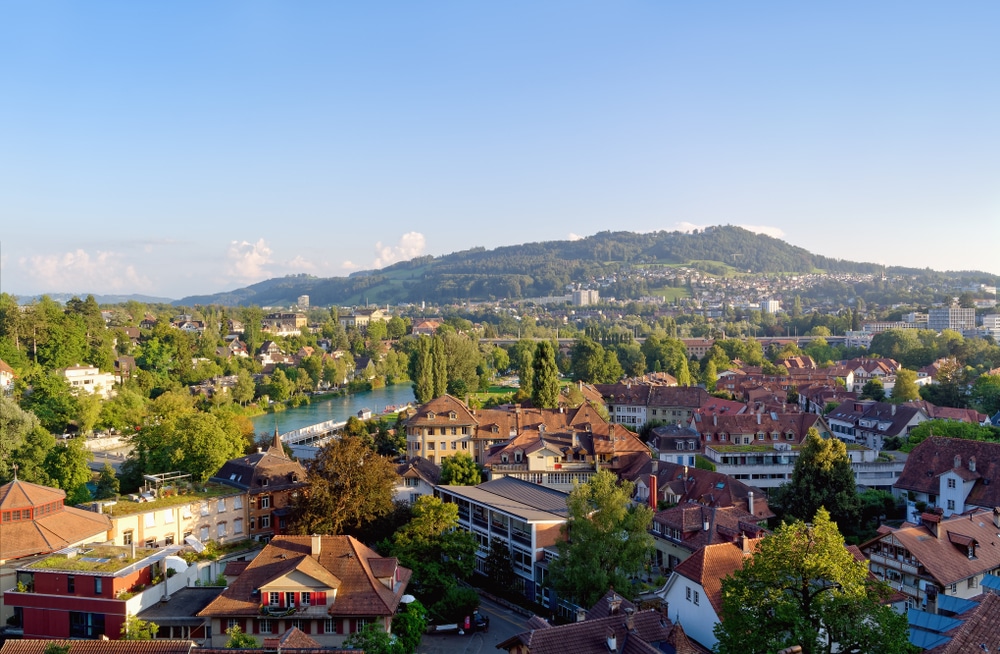 Source: lesart / Shutterstock
Source: lesart / ShutterstockBern has its own mountain, rising south of the city to 858 metres above sea level.
For many, the name “Gurten” is automatically associated with the Gurtenfestival, a four-day music extravaganza in mid-July, welcoming the likes of Gorillaz, Patti Smith and Massive Attack in the last decade.
At any other time, Gurten is a dose of pastoral Switzerland, with meadows, grazing cows and wonderful views of the Aare, Bern and the Bernese Highlands from its observation tower.
Come here for hiking, picnics, an activity-packed kids’ playground, sledding in winter and a summer toboggan run.
Getting to Gurten couldn’t be easier, as the S-Bahn lines S3 and S31 take you to the lower station for the Gurtenbahn, a funicular running 361 days a year, departing every 15 minutes and zipping you to the summit in no time at all.
7. Bern Historical Museum
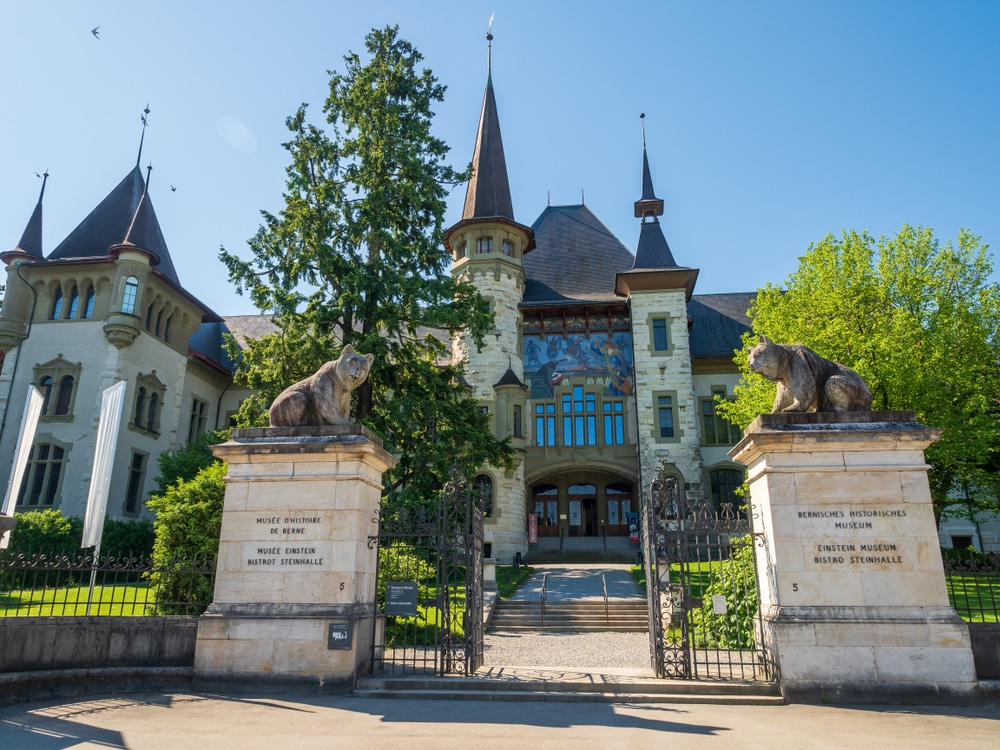 Source: Kolf / Shutterstock
Source: Kolf / ShutterstockYou can bet that the Bern Canton has a rich and eventful history, ready to be uncovered at Switzerland’s second-largest historical museum.
Even the venue is dramatic, in a turreted neo-Gothic building from 1894, modelled on castles from the 15th and 16th century.
The marquee exhibits are the treasures captured from the Burgundians in the 15th century after the victory of the Swiss Confederates over Charles the Bold.
Among them is a set of Flemish Tapestries of incredible technical sophistication, composed of the richest materials available.
The main exhibition also reveals the finery of the Ancien Régime, as well as dozens of pieces of gold and silverware belonging to Bern’s guilds and societies from the 16th to the 18th centuries.
There’s information about the canton’s Stone Age, Celtic and Roman past, as well as important collections for Ancient Egypt, the pre-Columbian Americas, the Far East, Oceania and the Islamic world.
Website: https://www.bhm.ch/en/
8. Kunstmuseum Bern
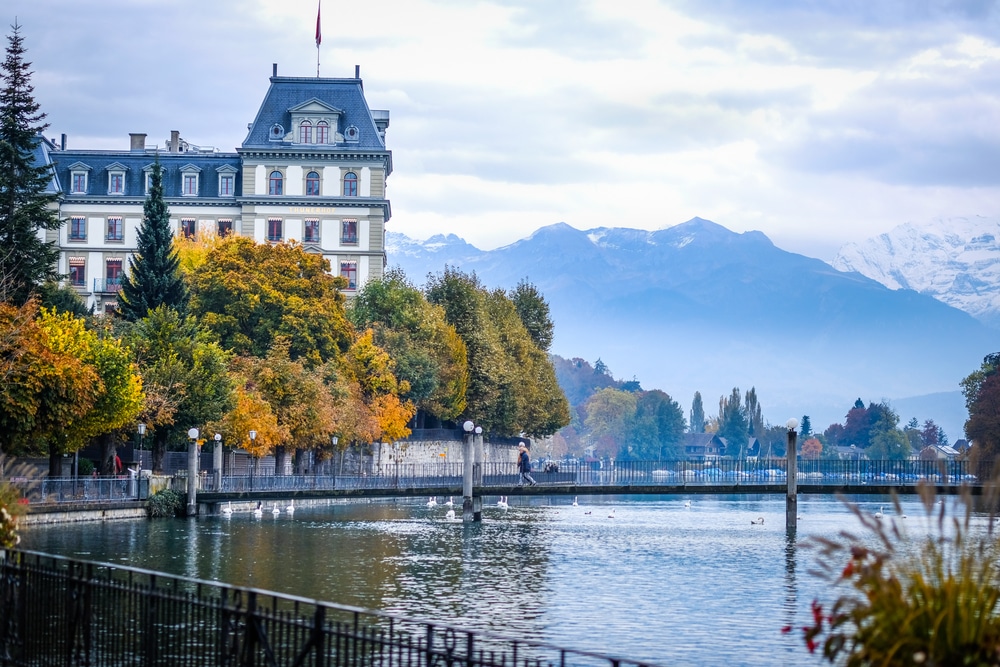 Source: ARIYATUCH / Shutterstock
Source: ARIYATUCH / ShutterstockBern’s Museum of Fine Arts has an international reputation for its cache of masterpieces spanning 800 years, but also for an excellent programme of temporary exhibitions.
A few of the names popping up in these galleries are Ferdinand Hodler, Cézanne, van Gogh, Lovis Corinth and Salvador Dalì.
The Kunstmuseum Bern is especially strong on German Expressionism, in particular the Blaue Reiter group, with pieces by Paul Klee of course, but also Kandinsky, August Macke and Franz Marc.
And you can also tap into the history of Bernese art, going back to the 16th century, with pieces by Niklas Manuel, who also contributed ornamental painting on the ceiling of Bern Cathedral.
Website: https://www.kunstmuseumbern.ch/
9. Bundeshaus
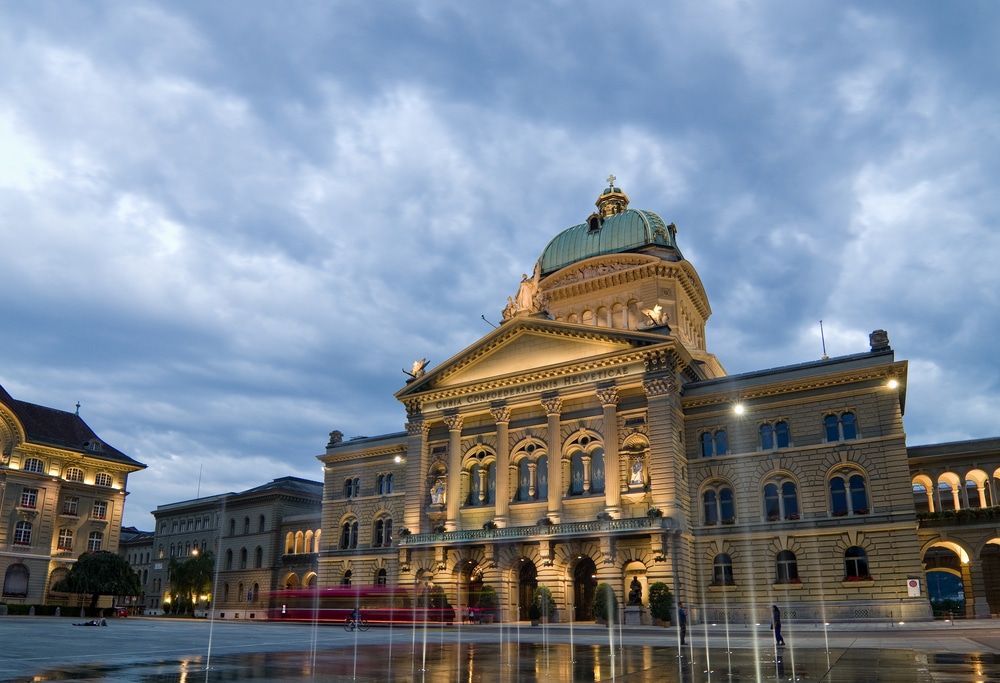 Source: Simon Zenger / Shutterstock
Source: Simon Zenger / ShutterstockTwo buildings punctuate Bern’s skyline: The Gothic tower of the cathedral and the majestic neo-Renaissance dome of the building housing the Swiss Confederation’s parliament and government.
Put up between 1894 and 1902 and designed by Hans Wilhelm Auer, the Bundeshaus is a clear statement of confidence from the then young Swiss federal state.
The complex extends over 300 metres, with Parliament meeting under its striking dome, and the state government and federal administration being based in the west and east wings respectively.
You can go on a free guided tour when Parliament isn’t in session. You’ll find out about Parliament’s inner-workings, and hear some background on the building’s history.
Some of the best parts are the magnificent lobby, the debating chambers for the National Council and Council of States, and of course the marvellous domed hall. Afterwards take some time out on the terrace to look over the Aare, the Marzili baths and the Gurten.
Website: https://www.parlament.ch/en/services/visiting-the-parliament-building
10. Bundesplatz
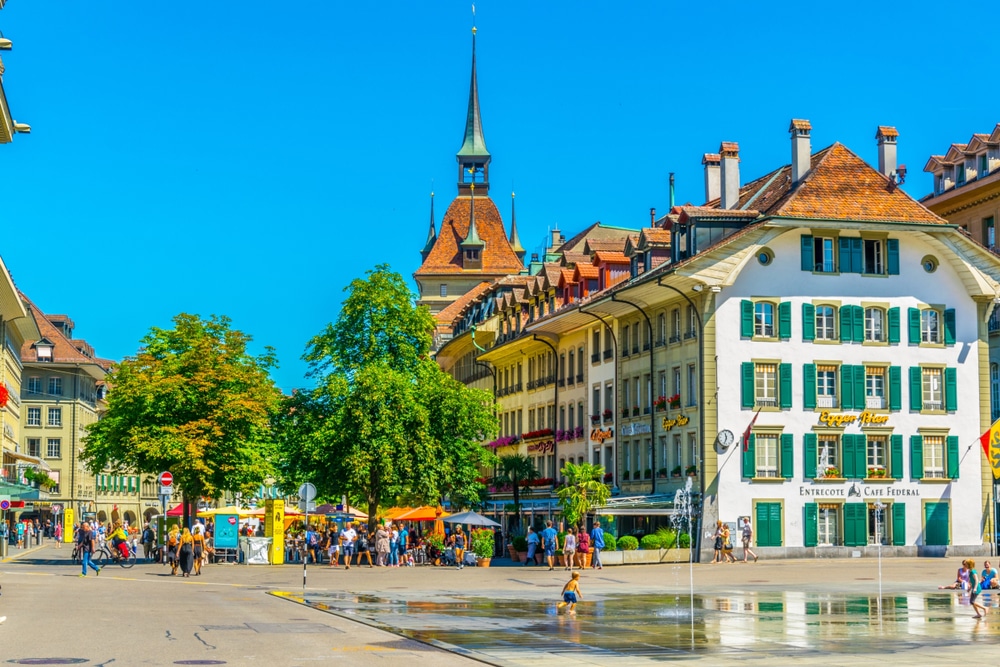 Source: trabantos / Shutterstock
Source: trabantos / ShutterstockA word on the plaza in front of the parliament building, which for decades was used as a car park until an award-winning redesign in the 2000s.
The western third of the square, where the fountain is today, is on the course of the old ditch that protected Bern’s second city wall from the 13th century onwards.
The fountain was unveiled in 2004 and leaping from the ground are 26 jets, each symbolising one of the 26 Cantons of the Swiss Confederation.
As you can guess, it’s a hit with families on hot summer days. The weekly market, trading on the square on Tuesday and Saturday mornings, is a time-honoured tradition for Bern.
In the festive season there’s an illuminated, 600-square-metre skating rink on the square, joined by stands for mulled wine and fondue.
A more recent but no less popular tradition is Rendez-Vous Bundesplatz from mid-October to mid-November, in which the Bundeshaus becomes a canvas for dazzling projections, following a different theme each year.
11. Rose Garden
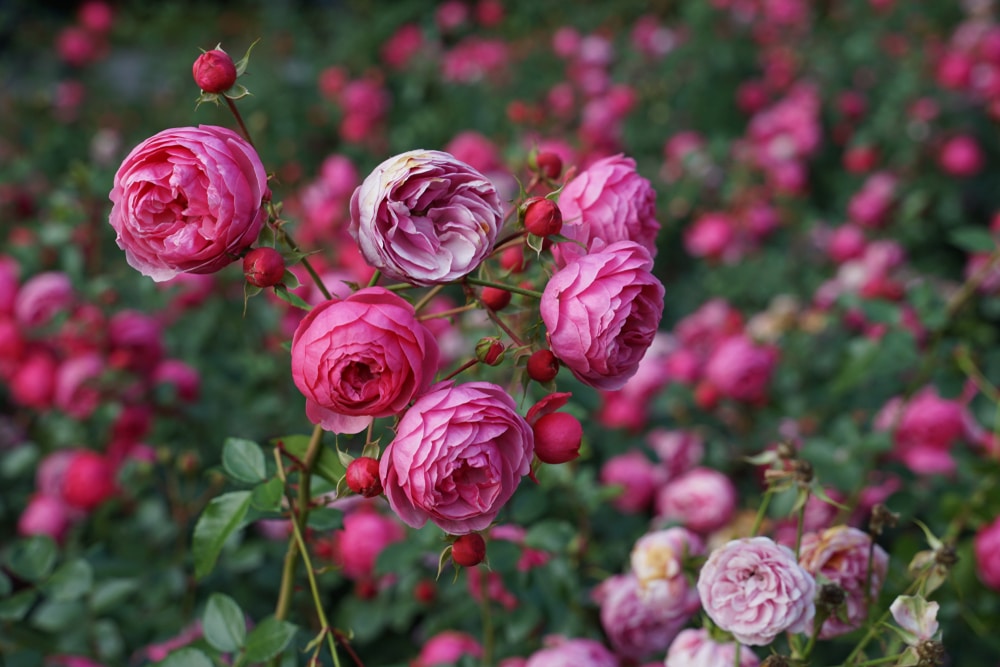 Source: Dewi Cahyaningrum / Shutterstock
Source: Dewi Cahyaningrum / ShutterstockIf you want to see the rooftops, spires and gables of Bern’s Old City from above, head for this park posted high on the river’s right bank.
Looking right along the loop in the Aare, the Rose Garden was first landscaped in 1765 and for the next 100 or so years was the city’s cemetery, later becoming a public park in 1913.
The picture-perfect layout greeting you now is from 1956-1962, with lawns bordered by beds for 400 types of roses as well as lush rhododendron bushes from 28 different varieties.
The Rose Garden is also loved for its cherry trees, bursting into flower around the turn of April. The main attraction has to be that west-facing terrace, lined with benches and a fine place to be as the sun goes down.
Commandeer an outdoor table at Restaurant Rosengarten in summer, or warm up in winter with fondue.
12. Bärengraben
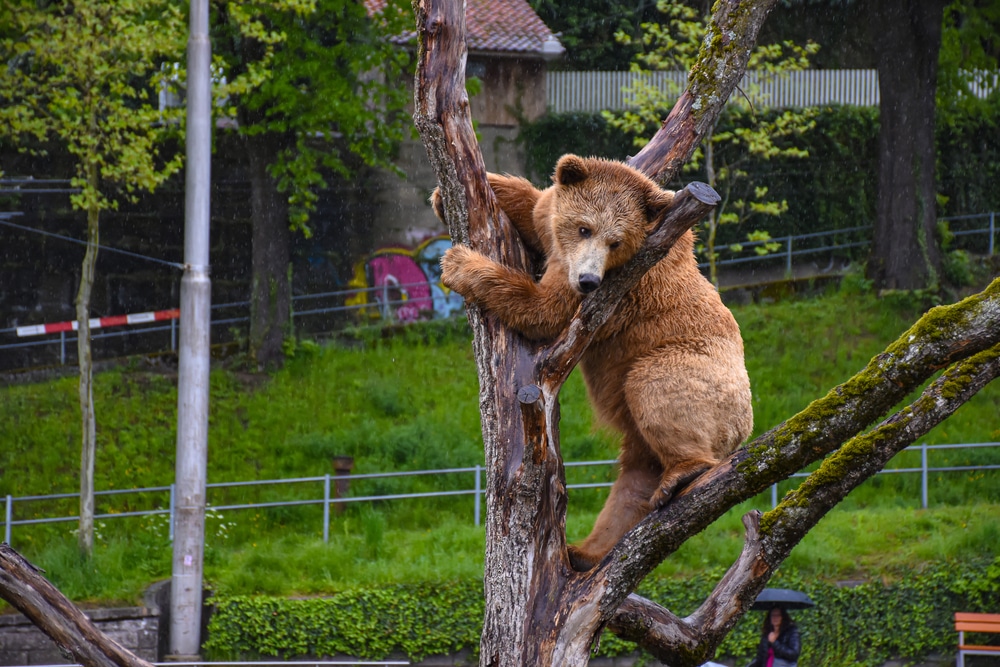 Source: Nebularpas / Shutterstock
Source: Nebularpas / ShutterstockBears hold a special significance for Bern, and are tied into the city’s heraldry and the etymology of “Bern” name, all relating to a founding legend.
The story goes that Berthold V, Duke of Zähringen (1160-1218) vowed to name the city for the first animal that he caught in the wood that was to be cleared for the new settlement.
This happened to be a bear, and this animal appears on the coat of arms for Bern and its surrounding canton.
Bears have been kept in pits around Bern since the beginning of the 16th century, and the current, heavily modified enclosure on the right bank of the Aare opened in 1857.
Recently this has been reconfigured to improve the welfare of its residents, Björk, Finn and Ursina, and these bears now roam a large terraced park on the steep slope swooping down to the river bank.
At the bottom, the enclosure uses a moat to separate it from the riverside footpath. And as in the wild, Bern’s bears are rarely seen during the winter when they spend most of the season hibernating.
From the upper level there’s also a pleasing view over the Aare back to the Old City.
Website: https://www.tierpark-bern.ch/index-en.php?frameset=200
13. Kindlifresserbrunnen
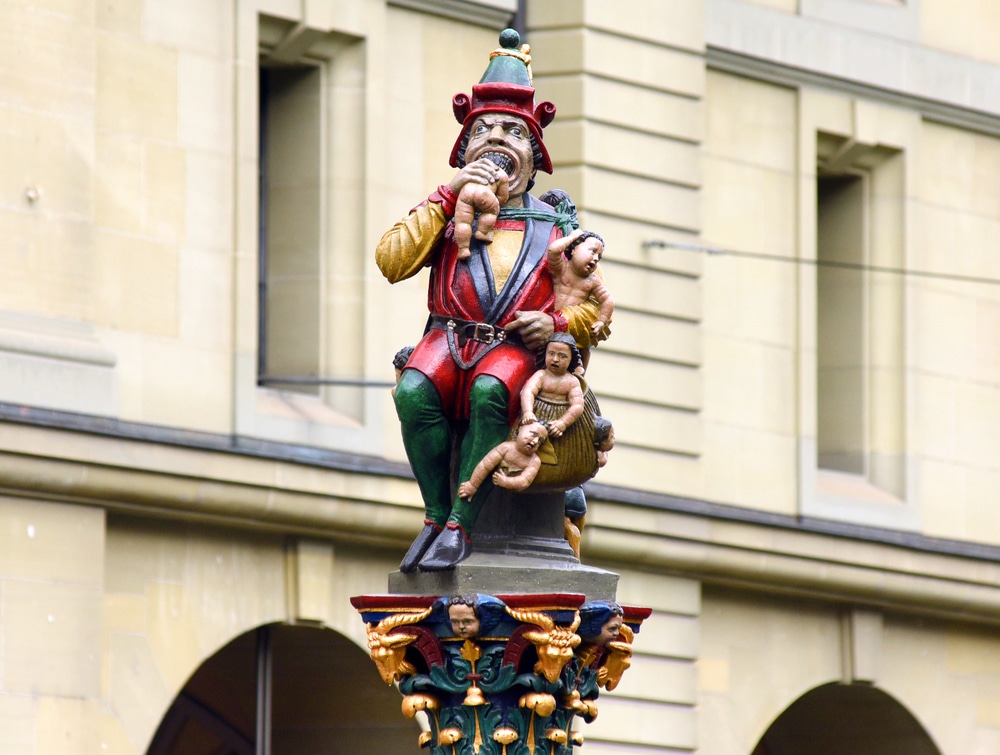 Source: Bumble Dee / Shutterstock
Source: Bumble Dee / ShutterstockOne of Bern’s representative sights belongs to that set of 16th-century drinking fountains littering the alleys of the Old City.
The rather alarming Kindlifresserbrunnen, literally Child Eater Fountain, shows an ogre biting into a child, with yet more children struggling in a sack and awaiting their fate.
As with Bern’s other Renaissance fountains, this sculpture stands at the top of a column. But what’s unknown is the exact meaning of the work.
Child eaters are a common Medieval image, and the Kindlifresserbrunnen may depict Saturn, Krampus or a contemporaneous figure from Swiss history, like Matthäus Schiner (1465-1522), a commander responsible for several bloody victories in Northern Italy.
It may also have antisemitic origins and represent a “blood libel” (an antisemitic woodcut from 1492 shows Saturn as a Jewish man committing such an act).
Or it could have a more benign meaning, warning Bern’s children against falling into the bear pit or simply being disobedient.
14. Marzilibad
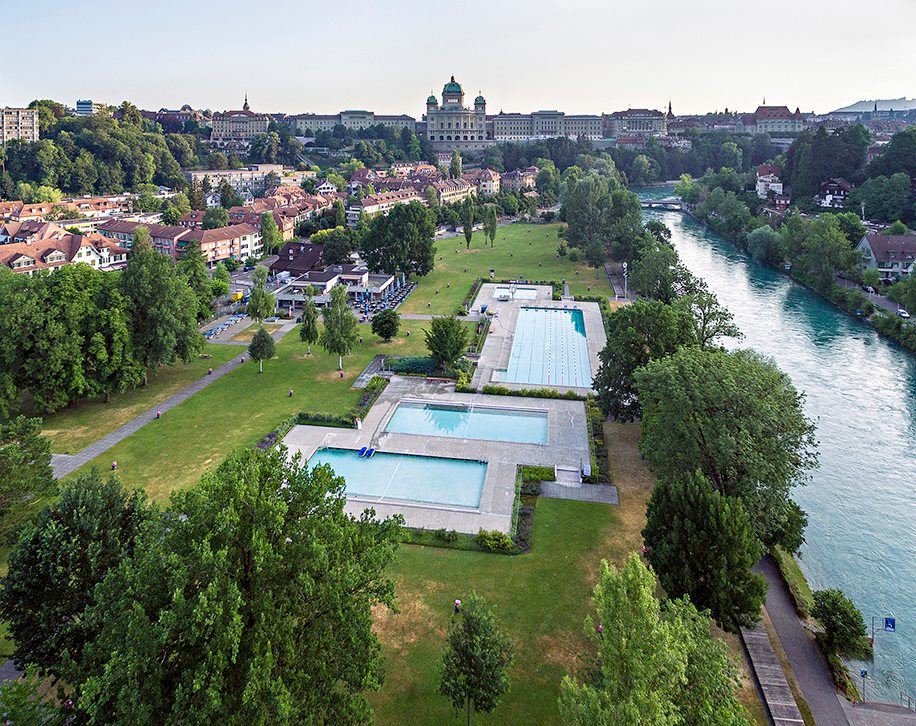 Source: facebook.com
Source: facebook.comWith the Bundeshaus as a dramatic backdrop you can visit Marzili to swim in the Aare, something Bern’s residents have done since time immemorial.
With free entrance and ample lawns for sunbathing, it’s not hard to see why this is one of the city’s favourite spots on hot summer days.
Experienced swimmers can brave the Aare of course, but there’s a whole pool complex to boot, including a 50m pool, a diving pool, two 25m pools for non-swimmers and a paddling area for little bathers.
Added to all that is ten hectares of green space, with towering mature trees, pingpong tables, beach volleyball courts and even a nudist bathing area for women in a privacy-protected courtyard.
When you’re peckish there’s the Badi-Restaurant, while the Gelateria di Berna is adored for its homemade gelato.
15. Matte
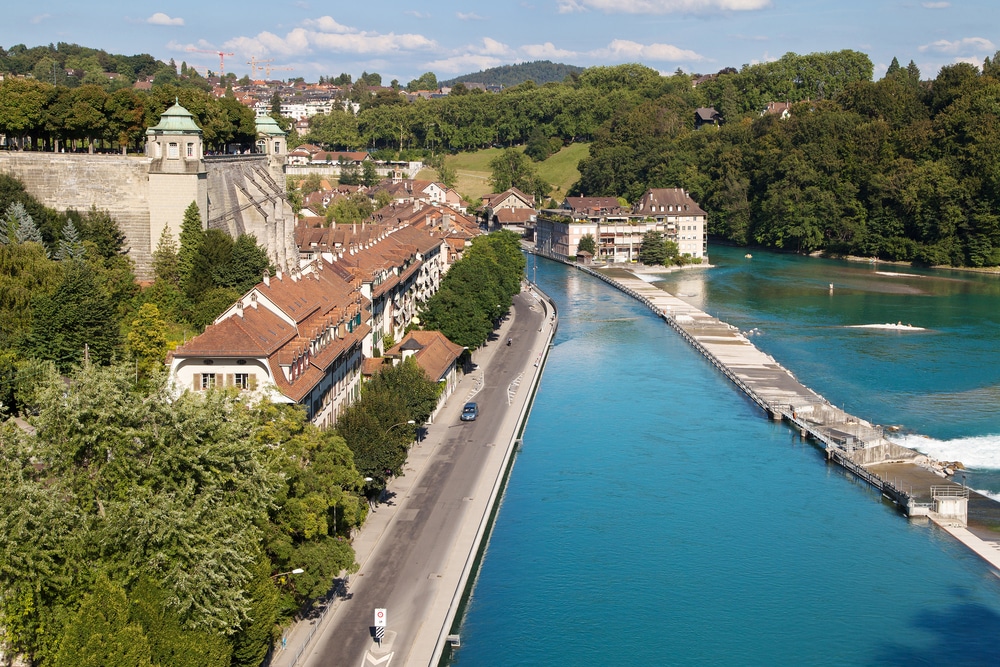 Source: Santi Rodriguez / Shutterstock
Source: Santi Rodriguez / ShutterstockDown by the water in the southeast of the Aare peninsula, Matte is a little and historic neighbourhood distinct from the more refined Zähringerstadt above.
This was a chaotic harbour and place of industry, crammed with workshops and mills. In fact if you look at the Aare next to Matte you can still see the three artificial channels built in the 14th century to power three city-owned watermills.
All of that activity has long since disappeared, replaced by cafes, galleries and artist studios. Badgasse, an alley below the cliff-like walls for the cathedral, refers to baths in the river that were visited by Giacomo Casanova in 1760.
Matte developed such a distinct character from the rest of the Old City that its inhabitants even had their own language, Matte Englisch, passed from father to son as a negotiating tactic at markets, and kept alive today by the Matteänglisch Club, with 350-odd members.
The neighbourhood’s main landmark is the vertical Matte Lift, which has a beautiful steel framework and has carried hundreds of passengers to and from the cathedral platform every day since 1897.
16. Gerechtigkeitsbrunnen (Fountain of Justice)
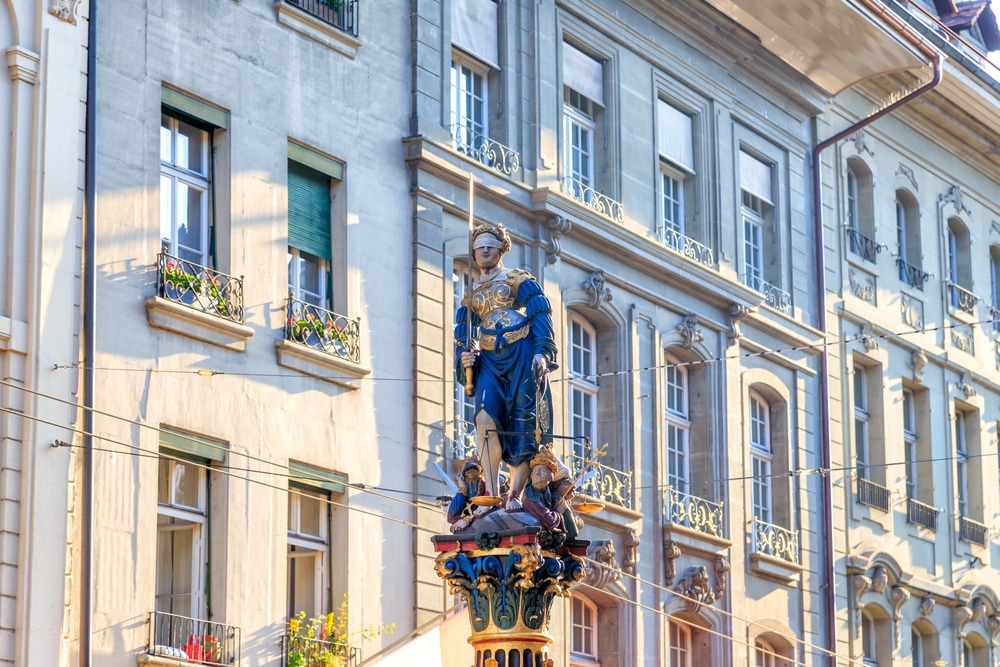 Source: Maykova Galina / Shutterstock
Source: Maykova Galina / ShutterstockA linchpin for the namesake street, Gerechtigkeitsgasse, this 16th-century fountain is crowned with a statue of Lady Justice, blindfolded and holding her customary sword and scales.
At her feet are a pope, emperor, sultan and mayor, and the column rises on a plinth from an octagonal limestone basin.
This is the only one of Bern’s 16th-century fountains to retain its original design, even if it has been vandalised at times, losing its sword in 1798 and being ripped from its base in 1986 by the Béliers, the Jura separatist group.
After that attack the original was moved to the Bern Historical Museum for restoration, while the work in place is a copy.
The sculpture is by Hans Gieng, responsible for most of Bern’s fountains from the 1540s, and is regarded as the most artistically accomplished. A great time to come and see it is early in the morning, when the sun rises directly behind the fountain on this east-west street.
17. Natural History Museum
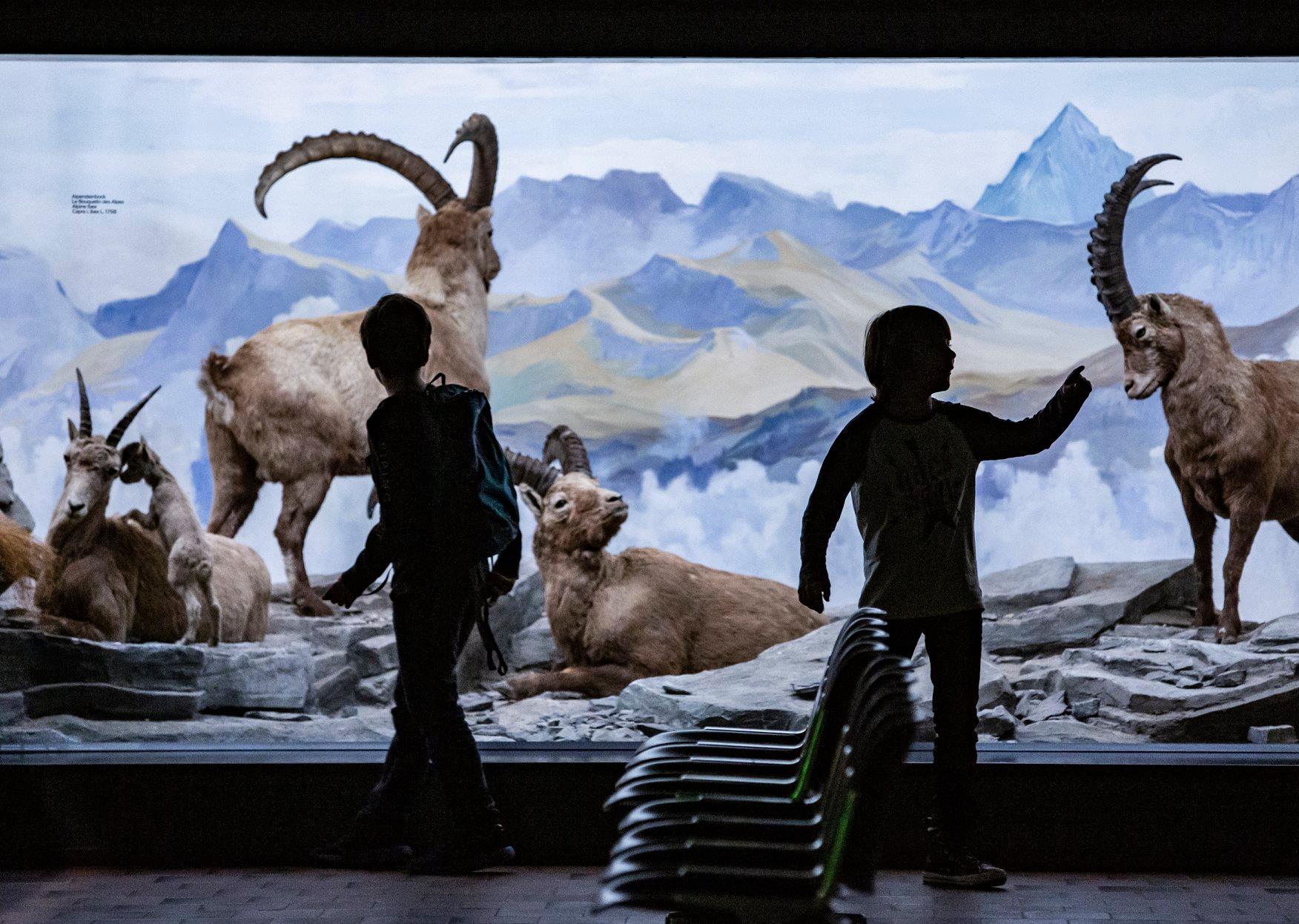 Source: facebook.com
Source: facebook.comIf you catch a rainy day you could pass some of it at the Natural History Museum, which conducts important research in fields like meteorites, palaeontology and arachnology, and has a collection of more than 6 million specimens.
If there’s one exhibit that brings in the crowds it’s Barry (1880-1814), possibly Switzerland’s most famous St Bernard, who was based at the Great St Bernard Hospice in the Pennine Alps and is thought to have rescued more than 40 people.
The museum also showcases the Planggenstock Treasure, discovered in 2005 and comprising one of the most important sets of quartz crystals in the Alps.
And for zoology, you can marvel at the 23-metre skeleton of a fin whale, as well as 220 historic and beautifully arranged dioramas.
Many of the predators in these tableaux were shot by big game hunter Bernhard von Wattenwyl a century ago. There’s some poetic justice though, as von Wattenwyl himself was killed by a lion in the Congo in 1924.
Website: https://www.nmbe.ch/en
18. Tierpark Dählhölzli
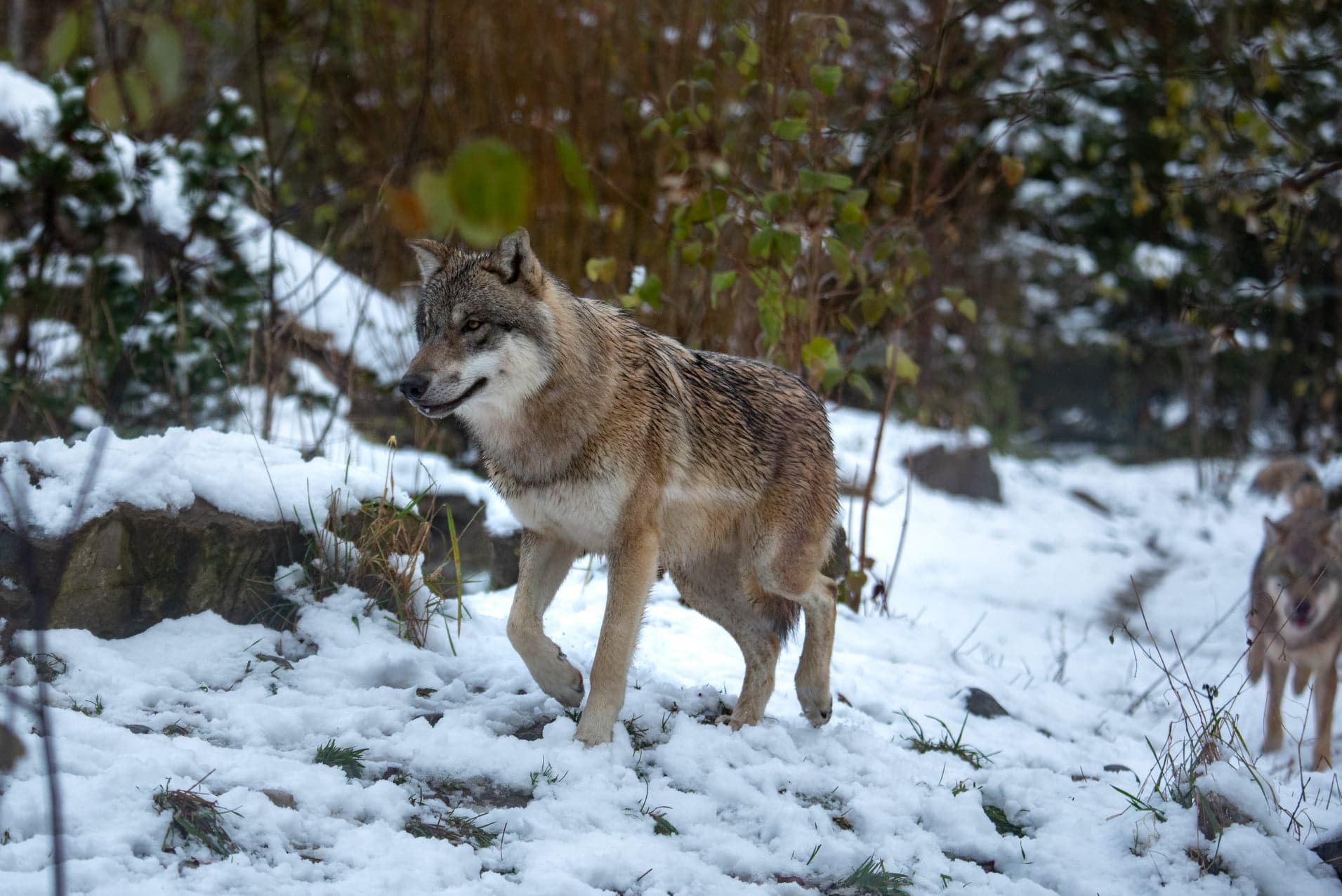 Source: facebook.com
Source: facebook.comSlightly upriver on the Aare, Bern’s public zoo also takes care of the bears in the Bärengraben.
The zoo opened in 1937, and since that time has been devoted mainly to native and European animals, priding itself on the amount of space it can provide to its inhabitants.
There are enclosures for grey wolves, brown bears, Alpine ibexes, arctic foxes, otters, carpathian lynxes, Greenland muskox, Finnish forest reindeer and seals.
You’ll also get up close to plenty of exotic animals like crocodiles, squirrel monkeys, persian leopards and basilisks.
Since the 2000s Tierpark Dählhölzli has grown and added several new enclosures, including a 600-square-metre environment for its leopards and a spacious aviary for snowy owls and eagle owls in 2015.
Website: https://www.tierpark-bern.ch/index-en.php?frameset=100
19. Käfigturm
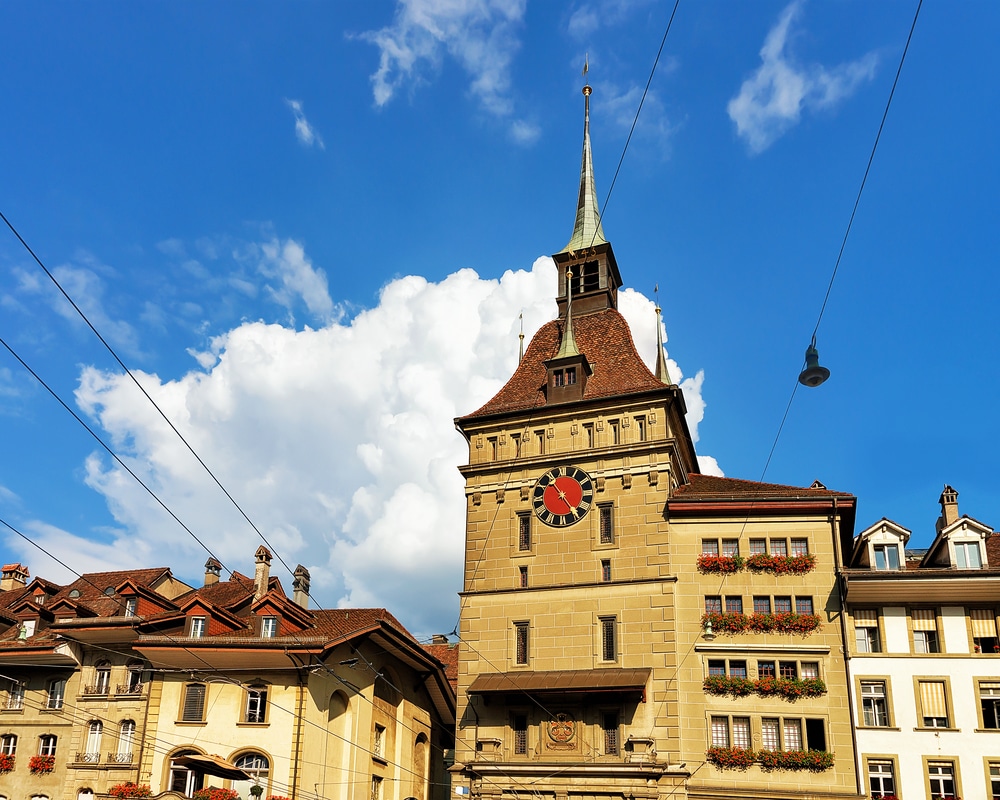 Source: Roman Babakin / Shutterstock
Source: Roman Babakin / ShutterstockIn Medieval times the predecessor to this 17th-century tower guarded the western entrance to Bern. The Käfigturm took over that defensive role from the Zytglogge, which after Bern’s first westward expansion was deep in the middle of the city.
Over time the city expanded further westwards, and the Käfigturm became a second line of defence and then a watch and signal tower.
But after the fire in 1405 the city’s prison was switched from the Zytglogge to this spot at the end of Martgasse.
The original Käfigturm was built in 1256, and the Baroque building you see now is from the early-1640s, while the clock face interrupting the tower’s row of corbels dates to 1690-91.
It’s remarkable to think that prisoners were kept here until as late as 1897, and graffiti on the old dungeon doors attest to their stays.
Since 1999 the Käfigturm has housed the Polit-Forum Bern, hosting panel discussions and debates on political topics. Right in front is the 16th-century Anna-Seiler-Brunnen symbolising temperance.
20. Museum of Communication
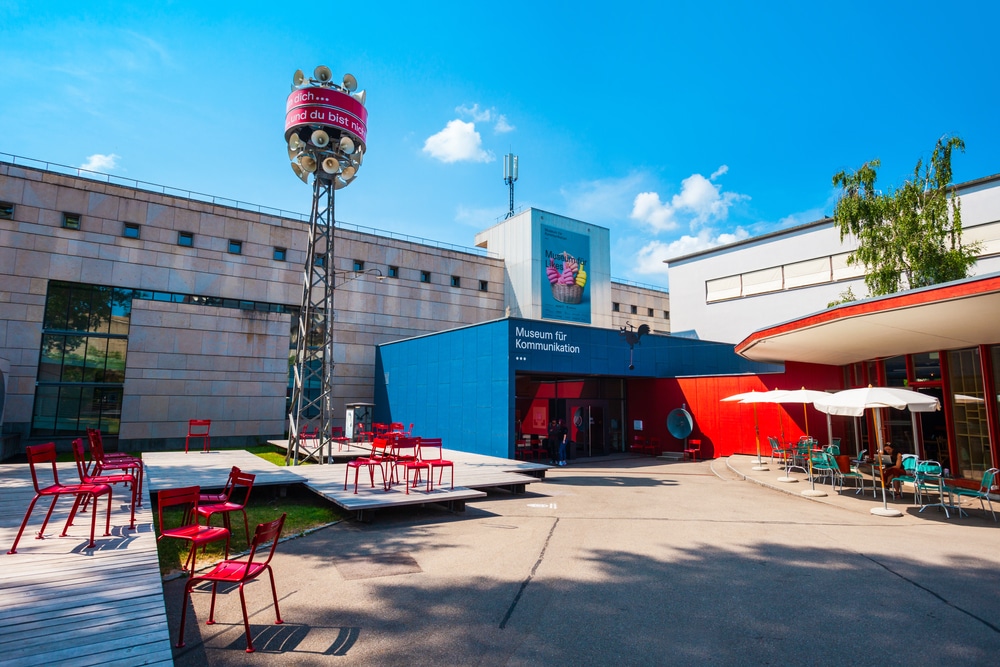 Source: saiko3p / Shutterstock
Source: saiko3p / ShutterstockInitially dedicated to the Swiss Federal Post Office, this museum opened as long ago as 1907, and in the 1990s broadened its theme from postage and stamps to communication.
On three levels, and using state-of-the-art technology and interactivity, this attraction tackles the history and development of communication, from a human rather than technological standpoint.
A new, award-winning redesign has filled the museum with massive video screens, lots of interactive stations, all kinds of curios as well as real, human communicators.
These all help raise fundamental questions like, “Why and with whom do we communicate?” and “What do we need to understand each other?”.
All kinds of engaging activities await, whether you’re hacking your friend’s computer, singing along to film karaoke, interviewing a virtual person and designing and printing your own stamps.
Website: https://www.mfk.ch/en/home-en/
21. Einsteinhaus
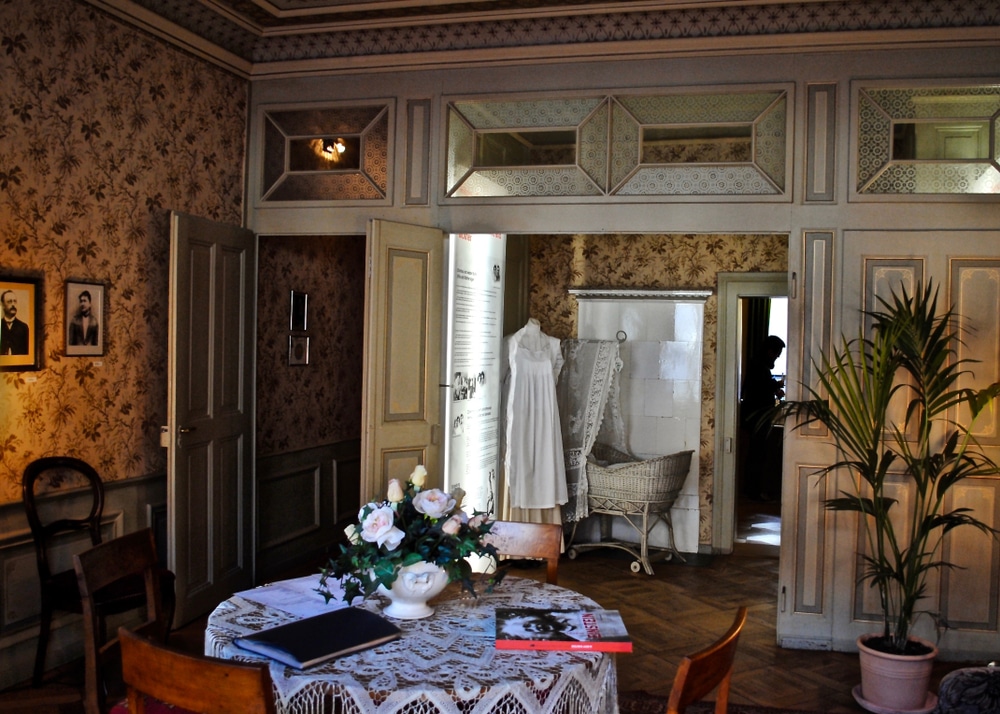 Source: EWY Media / Shutterstock
Source: EWY Media / ShutterstockBetween 1903 and 1905, while he was working at the Swiss Patent Office, Albert Einstein rented a second-floor apartment at Kramgasse 49.
The entire building has been turned into a museum to commemorate the groundbreaking physicist’s time in Bern in the first decade of the 20th century.
The second floor has been furnished in the same style as when Einstein and his first wife Mileva Marić and son Hans lived here.
The museum is imbued with extra significance as Einstein wrote his Annus Mirabilis papers here, introducing his theory of special relativity, and laying the groundwork for modern physics.
The exhibition on the third floor of the Einsteinhaus details Einstein’s biography and life’s work.
Website: https://www.einstein-bern.ch/en
22. Zähringerbrunnen
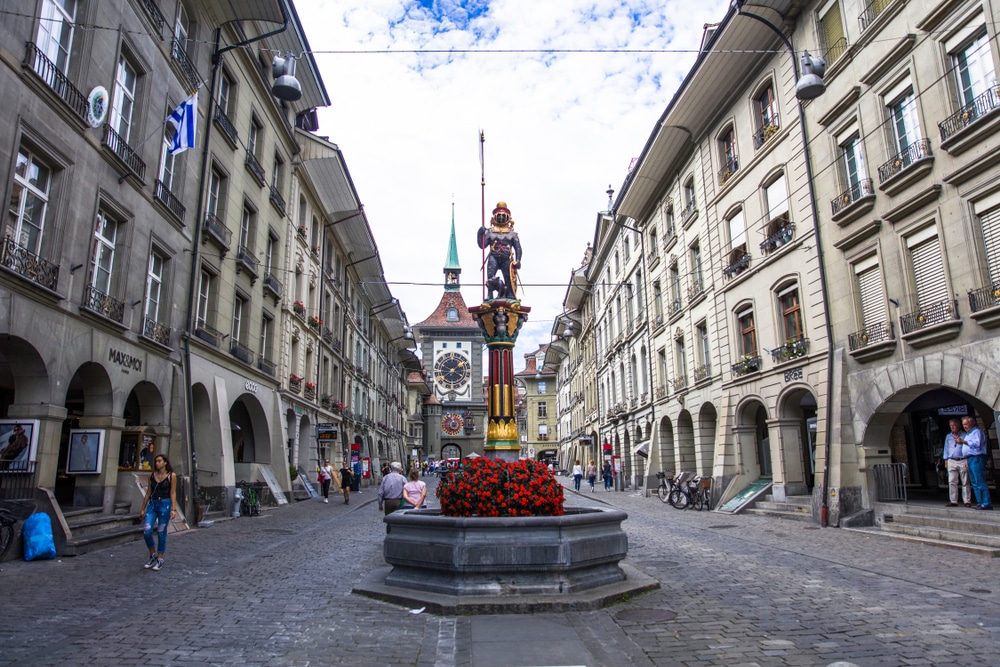 Source: Goran Bogicevic / Shutterstock
Source: Goran Bogicevic / ShutterstockA few steps east of the Zytglogge on Kramgasse you’ll come to another of Bern’s famed 16th-century fountains.
This pays tribute to Bern’s 12th-century founder, Berthold V, Duke of Zähringen, and the statue atop depicts a bear in full armour, referring to the legend in which the duke shot a bear on the Aare peninsula when he was searching for a site for the city.
The bear holds a banner and shield with a lion, the Zähringen emblem, and between the bear’s legs is a cub eating a bunch of grapes.
The fountain has been here since 1535 and owes its current appearance to a renovation in the 1880s when the basin was replaced and the statue was repainted.
Unlike the ten other Renaissance fountains in the Old City, this earlier work was produced by one Hans Hiltbrand, and not Hans Gieng, active in Bern in the 1540s.
As with the other fountains, the basin’s drinking water is supplied by the utilities company, Energie Wasser Bern and is regularly checked for its quality.
23. Bern Botanical Garden
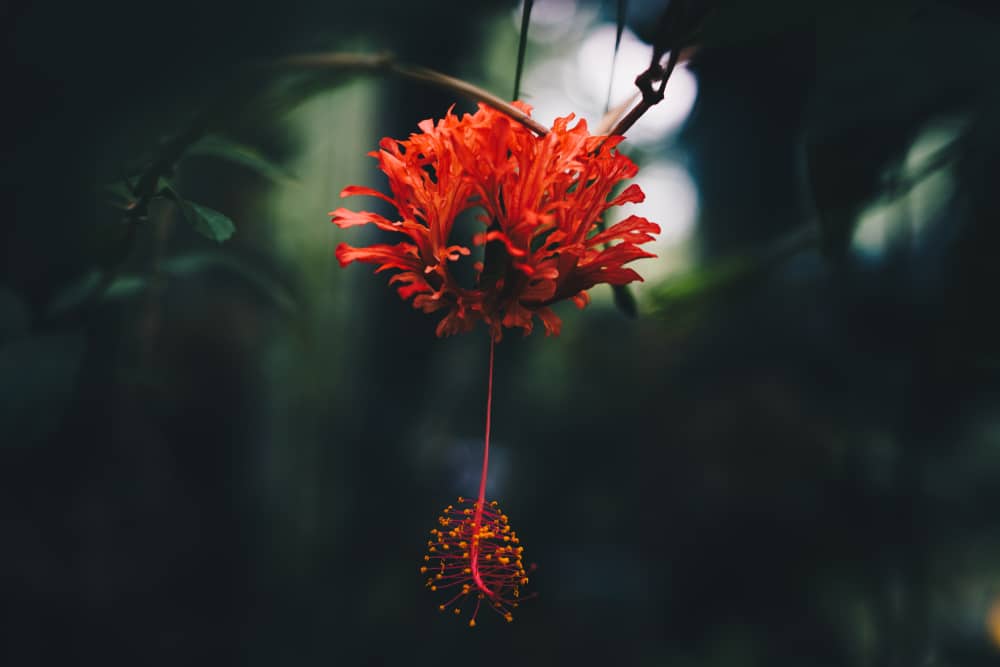 Source: Nino Rosset / Shutterstock
Source: Nino Rosset / ShutterstockThe University of Bern’s Botanical Garden has a history going back to 1789 when it was planted in the Marzili quarter.
Over the next 70 years the garden bounced around the city, before settling at its current location on the sunny right bank of the Aare by the Lorrainebrücke in 1859.
More than 6,000 plant species, many of which are medicinal, are packed into two hectares and six glasshouses.
The Palm House for instance grows tropical rainforest species and crops from this climate zone, like sugar cane, coffee, banana and pineapple, while there’s a house for desert and arid species and another for ferns and cycads from tropical mountain forests.
A real highlight is the Alpinum, a rock garden navigated by a trail, along which you’ll come across 1,500 mountainous plants from locations as diverse as the Alps, Himalayas, Rocky Mountains and the Caucasus.
Website: https://www.unibe.ch/university/services/botanical_garden/index_eng.html
24. Church of the Holy Ghost
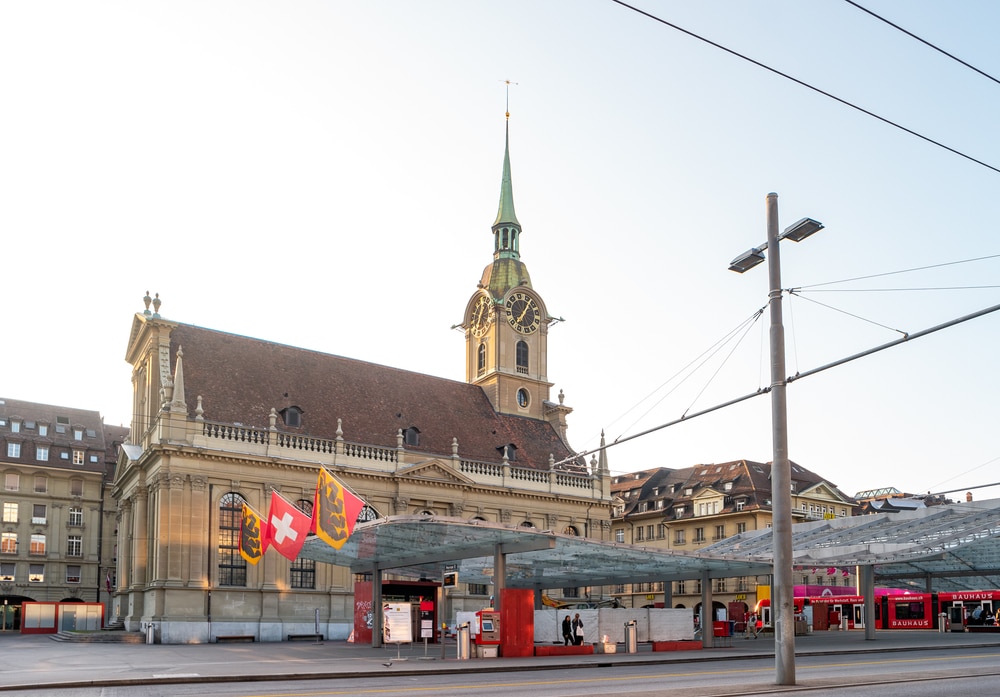 Source: Stetiukha Kristina / Shutterstock
Source: Stetiukha Kristina / ShutterstockA reference point on Bahnhofplatz on the west side of the Old City, this Baroque church was built in the 1720s from local sandstone, on the site of a demolished Medieval church first mentioned in the 13th century.
With a rectangular footprint, the Church of the Holy Ghost is surprisingly large, and is held as one of Switzerland’s most magnificent Reformed Baroque churches.
From the square you can admire the slender windows, the graceful spire, the two-storey Corinthian pilasters, the segmented gables at each end and the various urns and obelisks decorating the pediments and the balustrades down the sides.
Inside you can gaze up at the beautiful Rococo stucco ceiling, held up by 14 powerful Corinthian columns.
This is the finest example of Rococo decor in Bern and was executed by German plasterer and sculptor Joseph Anton Feuchtmayer (1696-1770).
The BarockZentrum Heiliggeistkirche organises a programme of Early Music concerts in the church throughout the year.
25. Kunsthalle
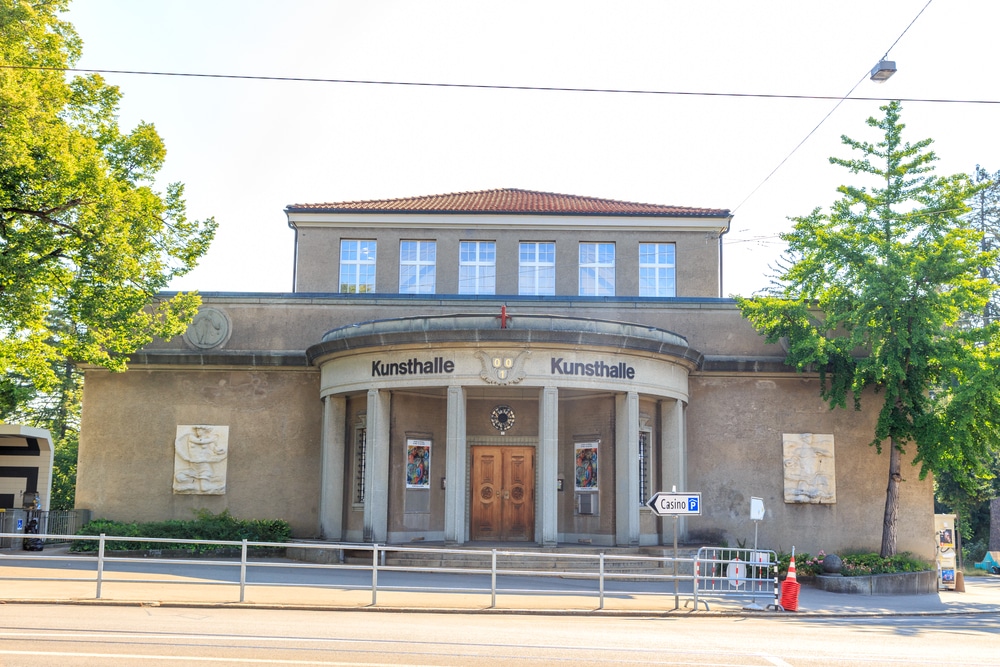 Source: Maykova Galina / Shutterstock
Source: Maykova Galina / ShutterstockIf you’re coming to Bern it’s always a good idea to find out what’s on at this exhibition hall, staging contemporary art shows.
On Helvetiaplatz, Kunsthalle opened in 1918 and holds around six solo, group and thematic exhibitions each year.
This includes the annual Cantonale Berne Jura, at the turn of the year, when you can view the best work by up-and-coming artists from the region.
The lineup of artists to have featured in exhibitions at the Kunsthalle is impressive, counting Henry Moore, Paul Giacometti, Paul Klee, Jasper Johns, Christo and Daniel Buren.
Website: https://kunsthalle-bern.ch/en/